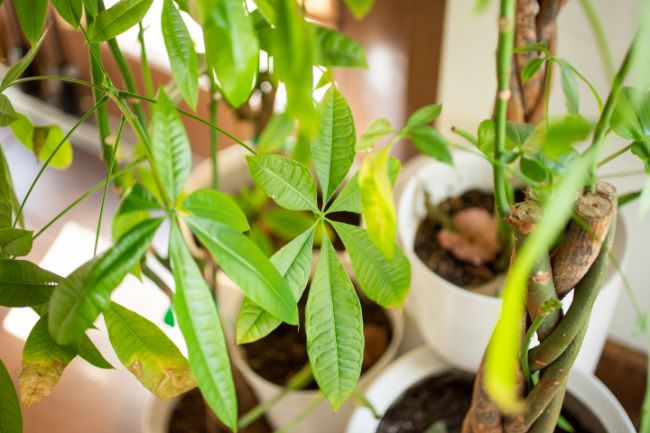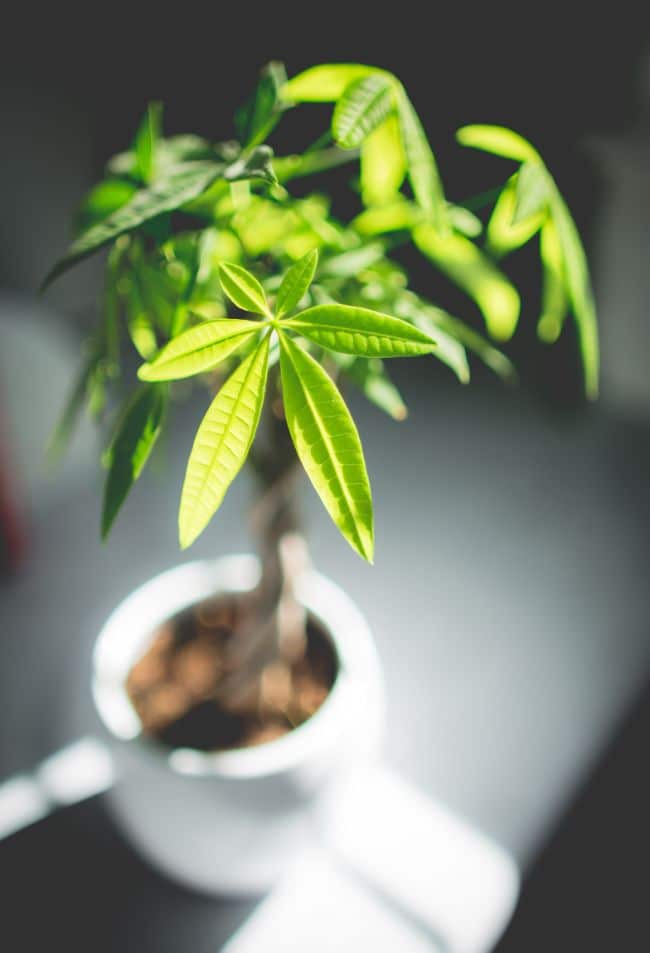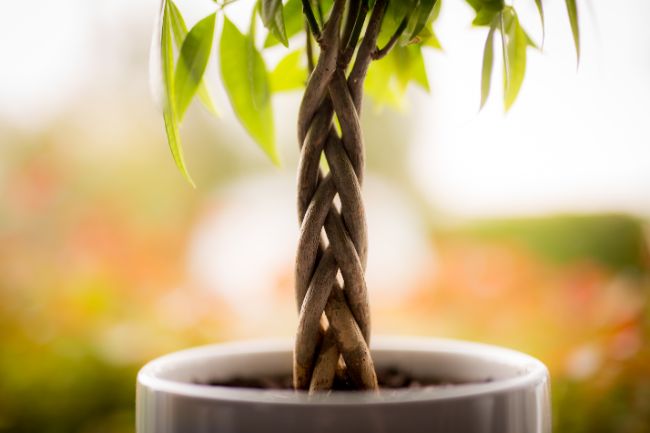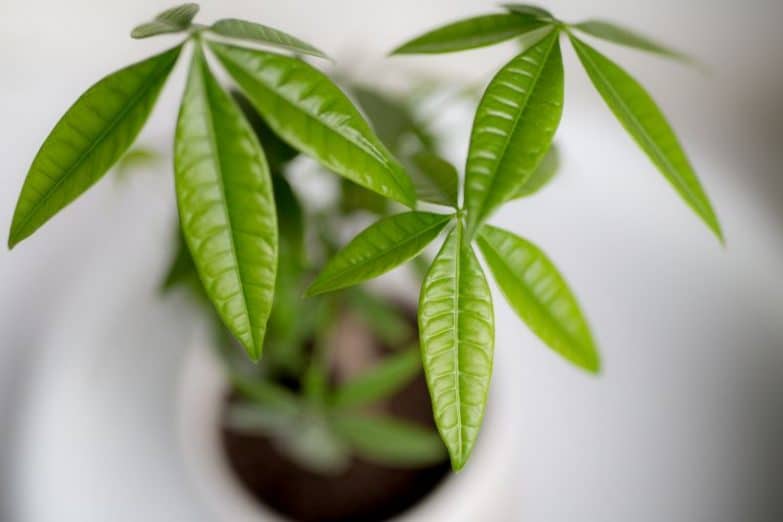Money Trees (Pachira aquatica), with their lush green foliage and braided trunks, are a sight to behold. Many people believe that this gorgeous plant brings good luck and fortune, but you may not feel this way if your Money Tree has yellow leaves. Thankfully, this article will help you fix your plant and help it thrive again.
The most common cause of a Money Tree developing yellow leaves is overwatering. Other causes include excess light or fertilizer, low humidity, underwatering, pests, temperature stress, transplant shock, or old foliage. The pattern of yellowing and other symptoms can help identify the issue.
Reasons Why Money Tree Leaves Turn Yellow
Money Trees (Pachira aquatica) are native to Central and South America and can grow up to 60 feet tall in the wild! However, most indoor Money Trees are small ornamental plants, with their tender stems braided together, and topped with lush green palmate leaves.
Although the Money Tree is usually a pretty undemanding and forgiving plant, if its leaves are turning yellow, it is a signal that something is not quite right. If you really care for your Money Tree, you should immediately identify the cause and take steps to fix the problem ASAP.
Let’s cover each problem in turn, and help you fix your plant:
Overwatering
Money Trees (Pachira aquatica) love moisture and they grow best when their soil is kept lightly moist. One of the most common reasons for yellow leaves on a Money Tree is being too attentive with watering.
Look for generalized yellow leaves, particularly affecting the lower leaves, and wilting of the plant, despite the soil being wet. You may also detect a rotting smell from the soil if overwatering has resulted in root rot.
Overwatering isn’t just caused by watering too frequently, but by anything that results in the soil being soggy for a prolonged amount of time. The following factors can all cause overwatering and result in a sick Money Tree, with yellow leaves:
- Planting in a pot without drainage holes.
- Planting in a pot that is too large.
- Watering too frequently, without waiting until the top 1-2 inches of soil feels dry.
- Not emptying the drip tray or cachepot after watering.
- Planting in poorly draining soil.
- Forgetting to reduce watering during winter or in colder conditions.
If your Money Tree is overwatered for a prolonged period of time, it might even die as the excess water causes its roots to rot.
How To Fix It?
If your Money Tree has yellow leaves and is wilting, despite the soil being wet, do the following:
- Stop watering until the top few inches of soil feels dry.
- Make sure your plant is potted in an appropriate pot and soil.
- Check for root rot. You may have to gently slide the plant out of the pot to examine the roots.
- If root rot is present, you should prune off any affected roots, wash the old soil off and plant carefully in a new pot with fresh soil. Follow my guide to treating and preventing root rot for more info.
The best way to determine when your money tree needs watering is to notice when its soil dries out. Don’t water your plant on a schedule, but check the plant and soil each time to determine if watering is required.

Underwatering
Overwatering and underwatering can cause similar symptoms in many houseplants. The difference with underwatering is that the soil will be dry, and the yellow, wilted leaves are more likely to feel dry and crispy. The pot will feel light due to the lack of water.
This can happen if your Money Tree’s water requirements increase, such as in warm weather, or when it is growing quickly. It can also happen if you simply forget to water your plant, or if the pot is too small or the plant is becoming rootbound.
How To Fix It?
Increasing the frequency of watering is the only way to ensure your Money Tree stays hydrated and happy. Try to keep its soil moist at all times.
If the pot holding your Money Tree is overly small, or there are lots of roots growing out of the bottom of the pot, consider repotting it to a slightly bigger one. Read my guide to repotting rootbound houseplants for more info.
Poorly Draining Soil
Poorly draining soil is a common cause of root rot in Money Tree plants, which then leads to loss of leaves, yellowing leaves, and can even kill your plant in severe cases.
Choosing the wrong potting soil or using a pot with inadequate drainage holes will reduce soil drainage. A large pot will also cause the soil to remain wet for a long time, increasing the risk of root rot.
How To Fix It?
Well-draining soil is a must if you want your Money Tree to stay healthy and thrive. If using a pre-made potting mix, consider adding some drainage amendments, such as perlite, coarse sand, or pumice to the soil.
Alternatively, you can easily make your own potting mix that will be just right for your plants. Read my guide to potting soil for houseplants to learn more.
When you water your Money Tree plant, the water should drain through the pot quickly, rather than pooling on top of the soil. Make sure the pot has plenty of drainage holes, and let the pot drain thoroughly after watering.
Sunlight Issues
You may have heard that the Money Tree is a plant that loves bright light and warmth, and decided to place it near a window where it is getting too much direct sun.
This can cause the leaves to become pale or yellow, and develop brown edges and scorch marks. The problem is – though a Money Tree prefers bright light, it should be ‘indirect’. So all that direct sun it is getting is probably scorching its leaves and turning them yellow.
A Money Tree is particularly susceptible to a sudden increase in light levels. If you need to move your Money Tree to a brighter location, it is best to do this in stages, every few days, allowing the plant some time to acclimate to the changing light.
How To Fix It?
The best place to put a Money Tree is in a partially shaded area or where it will get lots of bright, indirect light. Also, avoid frequent relocating as it does not appreciate sudden changes in lighting. Read my guide to light levels for houseplants to make sure you always give your houseplants the perfect amount of light.

Inadequate Humidity
Although the Money Tree can survive in low humidity, you may notice the leaves of your plant turning yellow or developing brown edges, particularly in winter months, when the central heating dries out the indoor air. This lack of humidity can cause the foliage to droop and turn yellow.
How To Fix It?
The most effective way to increase humidity for your plant is to use a humidifier. Alternatively, you can create your very own humidity-enhancing tray by adding a few small pebbles to a shallow tray, filling it with water to partially cover the stones, and then placing the plant on top of it.
You can read about more ways to increase humidity for your plants in this article.
Over-fertilizing
If you think that giving loads of fertilizer to your Money Tree is going to make it grow faster, you are wrong! Money Trees do not require heavy feeding – in fact, they fare better with less fertilizer rather than too much.
So if you notice yellowing or wilting leaves and you’ve been fertilizing regularly, consider this as a potential cause. Early signs of excess fertilizer include direct toxicity to the leaves, causing brown edges and intensely green leaves.
Excess fertilizer can also damage the roots, preventing them from absorbing the water and nutrients that the plant needs. This causes symptoms of water and nutrient deficiency, including leaf yellowing and drooping of the plant. You may also see white fertilizer salt crusts accumulating on the surface of the soil
How To Fix It?
Consider repotting into fresh soil, or flushing the soil with water to wash out excess fertilizer salts.
It is best to fertilize your Money Tree monthly during the warm months of spring and summer when the plant is actively growing. Stop fertilizing in autumn and winter.
Organic fertilizer releases nutrients more slowly, reducing the risk of overfertilizing. General-purpose fertilizers should usually be diluted to half the strength recommended for outdoor plants. Read my guide to fertilizing houseplants to learn everything you need to know about this aspect of houseplant care.
Fluctuating Temperatures
Sudden changes in temperature can also cause your Money Tree to develop yellow foliage. This is likely to happen when you place the plant in front of or near vents or drafts in a room.
Ideally, this plant thrives in a warm environment with the temperature falling between 65-85°F (18-29°C).
How To Fix It?
Check to see if your plant is near a drafty window or a heating or cooling vent. If it is, move it to a location where it will not be exposed to extremes of temperature. consider using a thermometer to monitor the temperatures your plant is exposed to.
I use a digital thermometer/hygrometer (link to Amazon) that tells me the current, high and low temperature, and humidity readings that the plant has been exposed to. A really helpful tool for ensuring good growing conditions.
Transplant Shock
If you have recently repotted your Money Tree and are suddenly noticing its leaves turning yellow, it might be because the plant is undergoing transplant shock and acclimatizing to its new environment.
How To Fix It?
The best solution is to find a nice, well-lit place for your Money Tree and provide conditions that are well within its preferred growing conditions. If you need to repot your plant, take great care to handle your plant with care during the process, and don’t do that too frequently.
And after moving it to a new environment, remember to pamper it a bit by ensuring it receives the ideal amount of light and humidity.

Pests
Just like any other houseplant, Money Trees can also attract pests like aphids, spider mites, mealybugs, or scale insects. Many sap-sucking pests will cause yellow spots on the leaves, where they have fed on the plant’s juices.
Over time, entire leaves can go yellow and your plant can suffer serious damage.
How To Fix It?
You should inspect your houseplants on a regular basis for any signs of pests. If you spot pests, you should immediately isolate the affected plant.
The first step should be to wash the plant’s foliage to remove as many bugs as possible. You can then use another treatment to further reduce the numbers and try to eliminate the infestation completely. Read my guide to identifying, treating, and preventing houseplant pests for more info.
Old Foliage
One common cause of a Money Tree getting yellow leaves that is nothing to worry about is aging foliage. Over time, even a healthy plant will get a few yellow leaves. This usually happens to lower, older foliage and should only affect a few leaves at a time if the plant is otherwise healthy.
The leaves normally turn yellow or brown all over and will fall from the plant in time. You should then remove these from around the plant to reduce the risk of fungal organisms accumulating on the decaying plant matter.
More yellow leaves will develop in the autumn, as the plant’s growth slows down due to falling light levels, and the plant decides to shed some leaves that are no longer required.
Last Word
Hopefully this article has helped you to think about why your Money Tree has yellow leaves. It’s important to consider all of the possibilities so that you can fix the right problem.
It’s probably best to think about the most common problems first, such as overwatering and lighting problems. Then move on to consider each of the other issues. don’t forget that sometimes there can be a combination of factors causing the issue, so it may be the time to make a few adjustments to improve conditions for your plant.
If you’d like to grow wonderfully healthy houseplants with ease, check out my book, Houseplants Made Easy. I cover everything you need to know to become a houseplant expert, growing wonderfully vibrant houseplants that will thrive for years.

